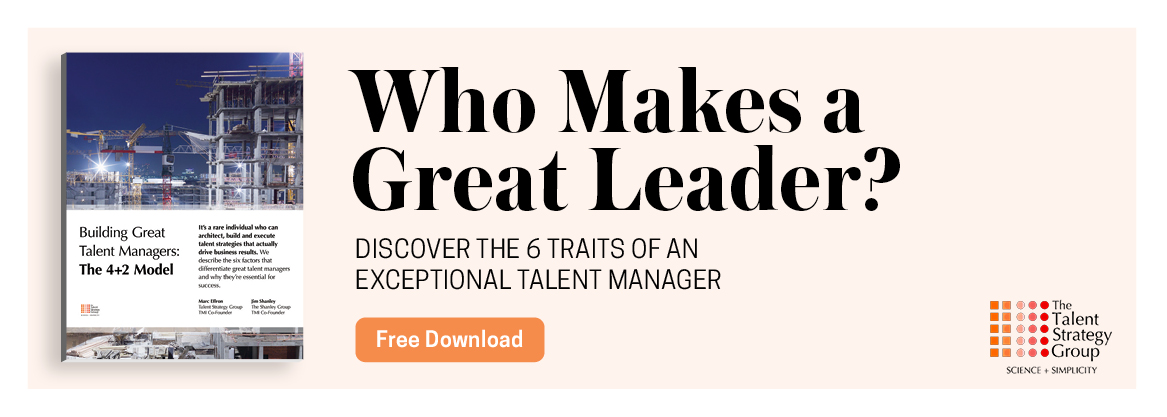Organizational resilience doesn’t just pay dividends during times of uncertainty—it’ll help a business thrive. Here’s how to grow and maintain it.
By Jillian Anderson and Susanna Mlot
Admit it: You never thought you or your organization would have to spend more than a full year continuing to live under the uncertain and ambiguous conditions that stemmed from the COVID-19 pandemic.
While this particular crisis has yielded creativity and agility on the parts of many disrupted companies—for instance, the quick pivots so many organizations made to virtual work, or the shifts that restaurants made to a delivery-based business mode—it’s also brought into clear focus the importance of organizational resilience as core to a sustainable and executable business strategy.
Sign up for the monthly TalentQ Newsletter, an essential roundup of news and insights that will help you make critical talent decisions.
The bank of organizational resilience a company builds, which we call the resilience variable, needs to factor into all facets of strategic planning, including scenario planning for shifting market conditions, examining the vulnerability of external dependencies, and being able to align around evolving customer needs. This variable becomes a key element in decisions about how to focus, leverage, and extend core organizational capabilities to meet the market in new ways.
The core mechanism that manifests the resilience variable is in a company’s approach to talent strategy. Long gone are the days when tending to employee “basics” like accurate payroll, onboarding, administering benefits, and processing transfers and promotions constituted compelling differentiators in the talent strategy. The resilience variable significantly ups the ante.
While an integrated talent ecosystem is one way to strengthen the connections between talent management and the business strategy, the resilience variable points to dimensions of talent strategy that we believe are now essential ingredients to success. The ability to create the conditions in which talent can grow, thrive, and be fully engaged rests squarely with leadership, whereby the endgame is to enhance and expand the capacity for organizational and workforce endurance through uncertainty, change, and complexity.
There are three pillars of a talent strategy that are essential to building the resilience bank. When these dimensions are fully developed, they serve not only to mitigate business risk, but to also create organizational environments in which people and the capabilities they bring to bear will flourish.
Pillar #1: Capability Focus
When building organizational resilience is central to talent strategy, a company is intentional about its focus on the organization’s differentiating capabilities. These capabilities are critical in building operating models that drive and enable sustained advantage.
Gaining resilience requires articulating what they are, how they create differentiation, where they need to be embedded, and then delivering the supporting programs through myriad aspects of the talent ecosystem. Identifying and preserving those strategic capabilities that are most crucial to driving business success can be a challenge for leaders.
Many organizations invest considerably in efforts to pinpoint their “secret sauce” and effectively deploy it as a differentiator. Sometimes this requires recalibrating lower value skills that may be inadvertently receiving overinvestment, flexibly redesigning and updating roles, or unlocking differentiating capabilities from within unintended silos to serve the broader strategic agenda.
Promoting the strength of core capabilities and their integration across the organization requires leadership keeping its finger on the pulse of both market and talent needs. Externally, leaders must frequently reassess what the market requires, and how organizational capabilities should be leveraged to deliver on those needs.
We observed the strategy evolution of an early-learning nonprofit for over a decade. The organization leveraged the deep knowledge, expertise, and relationships it had cultivated through its education and research focus to expand its impact through advocacy and professional development it began to offer to the broader field.
In one of several talent strategy changes, the company made a significant shift away from direct delivery of training and professional development, which was already beginning to tax the capacity limits of the current expert trainers and leaders, to a model that required expansion of its partner network and building “train the trainer” effectiveness to achieve scale. By keeping those capabilities strong and promoting them widely within the organization, they were able to meaningfully deliver on their mission in new ways.
Pillar #2: Compassionate Leadership
All you need to do is refresh LinkedIn to see dozens of examples of how leaders are demonstrating compassion and understanding as their people manage individual and family health hardships, blurred boundaries between work and home responsibilities, burnout, and an unparalleled amount of stress.
At the beginning of the pandemic, a study of global employees1 found 44 percent of respondents reported declined mental health related to working from home. Business leaders have taken on the challenge of bolstering employees even as they need to maintain deadlines, quotas, and margins.
How this impacts the resilience variable and talent strategy may involve offering flexibility and demonstrating empathy, outreach, and transparency to make a meaningful difference in employees’ experiences and retain their commitment to the organization.
Further, in larger organizations, mental health employee resource groups (ERGs)2 are an emerging way to embed a focus on wellness and self-care as part of rethinking traditional benefits. In leading organizations, the definition of employee wellbeing extends to financial health as well as physical and mental health.
Financial literacy is also becoming a component of the employee value proposition and wellbeing offerings in talent-focused organizations. Kevin Murphy, area president of Arthur J. Gallagher & Co.’s Georgia region, tells us employee wellbeing directly influences a company’s success, and AJG’s creative benefits offering now includes financial literacy training.
“As we dig deeper with our clients to explore the makeup of a thriving employee, we are observing a deepening correlation between engagement and financial wellbeing,” Murphy says. “Simply put, employers with intentional financial wellbeing offerings are reaping a far more engaged and productive workforce.”
Another element of compassionate leadership, enhancing trust between the employer and employees, also needs to be a talent strategy theme in a resilience play.
Long before the current environment put a premium on new ways of working, Stephen M.R. Covey and Douglas R. Conant3 made the business case for trust as “a hard economic driver for every organization.” In his neuroscience research, Paul J. Zak not only validated that trust is a driver for increased productivity, engagement, and satisfaction, but also, scientifically linked trust with environments that recognize excellence, promote collaborative problem-solving, provide autonomy and choice, and demonstrate transparency4.
Leaders will need to find their own authentic brand of compassionate leadership and should consider the potential opportunities they have to build flexibility into ongoing ways of working. These choices build dividends toward employee trust and commitment, which in turn will enhance organizational strength and durability and build up the resilience bank.
Pillar #3: Connection
Many companies have embraced remote work for the long term5, either as the full model for some segments of the workforce, or as part of a hybrid model. Both models enable them to reduce their physical footprint and provide more flexible arrangements for their employees.
The implications of leading a largely decentralized workforce are significant, however, and perhaps too early to measure fully. Managers who once had direct visibility into their team’s activities have had to find new ways to assess employees’ impact, productivity, and engagement. Decisions and judgments based on less proximate workplace relationships may be more susceptible to factors not directly related to job performance.
With workplaces as we once knew them now reconfigured or even dismantled, personalized connections and the direct, informal observations that contribute to decisions within the talent ecosystem are at risk of unraveling and contributing to disconnection between people, talent programs, and business strategy.
Another element of the new resilience-focused talent strategy, then, is equipping leaders and managers with the skills, tools, and mindsets to manage the potential downside of permanent virtual arrangements, and performance and talent calibration methods that help make up for the absence of direct observation in a workplace setting.
Lisa Abbott, senior vice president of human resources and community affairs at Lifespan Health in Providence, Rhode Island, helped the health system recognize the benefits of remote virtual work for healthcare employees who did not need to be on site. Lifespan also proactively addressed the dual risks of disconnection among employees working remotely and frontline workers facing ongoing stress and potential burnout.
“The benefits of remote working are incredible,” Abbott says. “People are really happy to have the flexibility. Childcare, eldercare, pet care—lots of problems get solved by working from home that we’ve been fighting against since the dawn of time.”
But there’s a big problem with the new model that organizations need to address, says Abbott: “the loss of place, workplace identity, and the ability to get certain kinds of work done in informal conversations.”
Abbott continues: “Also, being home alone or with one’s family 100 percent of the time is not for everyone. Feeling isolation is real, and so is burnout for our frontline workers. We’re turning our attention to putting more and more robust mental health supports in place and eliminating the stigma attached to saying ‘I need help’ to ensure connection and compassion for our people.”
The right mix of programs and focus to drive connection through intentional architecting of employee experience may vary by company, but it’s been shown to yield meaningful returns on investment. ThriveXM6 has found that companies prioritizing employee experience outperformed their industries’ average return on equity in Q1 and Q2 2020 by nearly 10 percent. For example, those companies found to be most successful shared common practices related to continuous learning culture, feedback loops that allow employee voices to be heard, and a stress management focus.
ERGs can provide support and also demonstrate a company’s commitment to employees’ experience and wellbeing. Although not all organizations have embraced the ERG concept7, research conducted in 20188 shows that in addition to communication and inclusivity, ERGs may serve as a vehicle for career advancement and leadership development through strategic leadership opportunities, exposure to leadership, investment from mentors, and challenging project engagement.
Retaining and elevating strong employees—especially those from underrepresented backgrounds—fosters not only close connections, but also, deeper roots for critical strategic and leadership capabilities.

5 Principles for Building a High-Resilience Strategy
To ensure the resilience variable is an integral element of your organization’s business and talent strategies, follow these five guiding principles:
1. Know true organizational strengths: Continuously assess and bolster core capabilities, and ensure your ability to deliver on those capabilities isn’t left vulnerable.
2. Connect everything: Eradicate silos by enhancing connections between employees, teams, individual work, the business strategy, and its objectives.
3. Measure innovatively: Assess the employee experience, engagement, inclusion, and impact by harvesting existing data with non-invasive tools rooted in AI to supplement traditional survey methods.
4. Create alignment: Define and organize around a leadership ethos that supports choices and investments to build up the resilience bank.
5. Create meaning: Lead by example. It’s the primary demonstration of company values and what the company prioritizes.
We’ve all been learning quickly how changing circumstances can test previous assumptions. By hardwiring organizational resilience into your business strategy through capability focus, compassionate leadership, and connection, you can protect your most valuable assets against unforeseen twists and turns in the future.
Jillian Anderson is a manager at Axiom Consulting Partners. Her strong program management skills and deep analytical capabilities help clients plan and execute on logical, tailored actions. With a background in education and communications, Anderson also contributes to the design, writing, and production of data-rich reports to help clients better understand critical issues and make more informed decisions.
Susanna Mlot is a partner at Axiom Consulting Partners. As a 30-year consultant and healthcare executive, she has partnered with clients to enable their achievement of excellence in execution and building capabilities in the critical pathways to profitable growth. Her expertise includes change management, strategy development and articulation, organization design, and workforce planning and development.
References
- https://www.qualtrics.com/blog/confronting-mental-health/
- https://hbr.org/2020/05/how-to-form-a-mental-health-employee-resource-group
- https://hbr.org/2016/07/the-connection-between-employee-trust-and-financial-performance
- https://hbr.org/2017/01/the-neuroscience-of-trust
- https://www.forbes.com/sites/jackkelly/2020/05/24/the-work-from-home-revolution-is-quickly-gaining-momentum/?sh=4f8ec66a1848
- https://news.sap.com/2020/10/thrive-xm-study-2020-employee-experience-business-results/#:~:text=The%20new%20Thrive%20XM%20Index,is%20what%20makes%20the%20difference.
- https://hbr.org/2017/08/deloittes-radical-attempt-to-reframe-diversity
- https://www.i4cp.com/press-releases/new-i4cp-report-reveals-ergs-as-effective-leadership-development-tool


